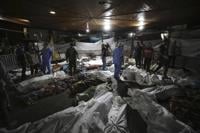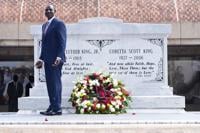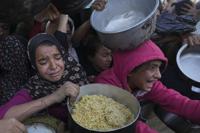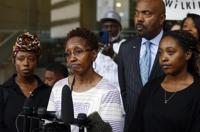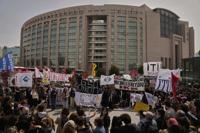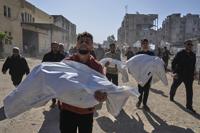JERUSALEM (AP) — How many Palestinians have been killed in the Gaza Strip since the war between Israel and Hamas started?
With Israel territory at a scale never seen before, arriving at a precise answer isn't easy. Cell service is spotty. Internet and power are out. Airstrikes have pulverized roads and , slowing rescue work.
Doctors scribble on notepads in and , struggling to account for bodies trapped under rubble and tossed in hastily dug mass graves. The chaos has added to the likelihood of errors.
Yet the Gaza-based Ministry of Health — an agency in the — continues to tally casualty numbers.
The ministry is the only official source for Gaza casualties. Israel has , barring foreign journalists and humanitarian workers. The AP is among a small number of international news organizations with teams in Gaza. While those journalists cannot do a comprehensive count, they’ve viewed large numbers of bodies at the sites of airstrikes, morgues and funerals.
The United Nations and other international institutions and experts, as well as Palestinian authorities in the West Bank — rivals of Hamas — say the Gaza ministry has long made a good-faith effort to account for the dead under the most difficult conditions.
“The numbers may not be perfectly accurate on a minute-to-minute basis,” said Michael Ryan, of the World Health Organization’s . “But they largely reflect the level of death and injury.”
In previous wars, the ministry's counts have held up to U.N. scrutiny, independent investigations and even Israel's tallies.
But an outlier is the ministry’s death toll from an explosion at in Gaza City in mid-October.
There were conflicting accusations of who was responsible, with Hamas officials blaming an Israeli airstrike and Israel saying it was caused by a an errant rocket launched by Palestinian militants. U.S. and French intelligence services also concluded it was likely caused by a misfired rocket. of video, photos and satellite imagery, as well as consultation with experts, showed the cause was likely a rocket launched from Palestinian territory that misfired and crashed. However, a definitive conclusion couldn't be reached.
There have also been conflicting accounts of the explosion’s death toll. Within an hour, Gaza's ministry reported 500 Palestinians killed, then lowered that to 471 the next day. Israel says the ministry inflated the toll. American intelligence agencies estimate 100 to 300 people killed, but haven't said how they arrived at the numbers.
The confusion has called into question the ministry’s credibility in the Hamas-ruled territory.
Here’s a look at how Gaza’s Health Ministry has generated death tolls since the war started.
HOW DOES THE MINISTRY ARRIVE AT A DEATH TOLL?
Gaza’s most widely quoted source on casualties is Health Ministry spokesperson Ashraf al-Qidra. From an office at Shifa Hospital in Gaza City, al-Qidra receives a constant flow of data from every hospital in the strip.
Hospital administrators say they keep records of every wounded person occupying a bed and every dead body arriving at a morgue. They enter this data into a computerized system shared with al-Qidra and colleagues. According to screenshots hospital directors sent to AP, the system looks like a color-coded spreadsheet divided into categories: name, ID number, date of hospital entry, type of injury, condition.
Names aren't always available, al-Qidra said. He and colleagues face disruptions because of spotty connectivity but say they call to double-check the numbers.
The ministry collects data from other sources, too, including the Palestinian Red Crescent.
“Every person entering our hospital is recorded,” said Atef Alkahlout, director of Gaza’s Indonesian Hospital. “That’s a priority.”
The ministry releases casualty updates every few hours, providing the number of dead and wounded with a breakdown for men, women and minors. The ministry generally doesn't provide names, ages or locations of those killed. That information comes from reporters on the ground or the Hamas-run government media office.
But on Oct. 27, in response to U.S. doubts over its figures, the ministry released a 212-page report listing every Palestinian killed in the war so far, including their names, ID numbers, ages and gender. A copy of the report shared with the AP named 6,747 Palestinians and said an additional 281 bodies have not yet been identified. The list did not provide a breakdown by location.
The ministry never distinguishes between civilians and combatants. That becomes clearer after the dust settles, when the U.N. and rights groups investigate and militant groups offer a tally of members killed. The Israeli military also conducts post-war investigations.
The Health Ministry doesn't report how Palestinians were killed, whether from Israeli airstrikes and artillery barrages or other means, like errant Palestinian rocket fire. It describes all casualties as victims of “Israeli aggression.”
That lack of transparency has drawn criticism.
“When the Hamas health agency comes out with the numbers, take it with a pinch of salt,” Lt. Col. Richard Hecht, Israeli military spokesman, said in a briefing. But he repeatedly declined to offer any alternative number of Palestinian casualties.
Israel says more than 1,400 civilians and soldiers were killed and over 200 hostages seized .
WHO WORKS IN THE MINISTRY?
Hamas, as Gaza's ruling authority, exerts control over the Health Ministry. But it's different than political and security agencies that Hamas runs.
The Palestinian Authority, which controlled Gaza before Hamas overran the area in 2007, retains power over health and education services in Gaza, though it's based in the occupied West Bank. The ministry is a mix of recent Hamas hires and older civil servants affiliated with the secular nationalist Fatah party, officials say.
The Fatah-dominated authority that administers Palestinian cities in the Israeli-occupied West Bank has its own health ministry in Ramallah, which still provides medical equipment to Gaza, pays Health Ministry salaries and handles patient transfers from the blockaded enclave to Israeli hospitals.
Health Minister Mai al-Kaila in Ramallah oversees the parallel ministries, which receive the same data from hospitals. Her deputy is based in Gaza.
The Ramallah ministry said it trusts casualty figures from partners in Gaza, and it takes longer to publish figures because it tries to confirm numbers with its own Gaza staff.
Hamas tightly controls access to information and runs the government media office that offers details on Israeli airstrikes. But employees of the Health Ministry insist Hamas doesn’t dictate casualty figures.
“Hamas is one of the factions. Some of us are aligned with Fatah, some are independent,” said Ahmed al-Kahlot, director of Kamal Adwan Hospital in northern Gaza. “More than anything, we are medical professionals.”
WHAT IS THE TRACK RECORD FROM PAST WARS?
Throughout four wars and numerous bloody skirmishes between Israel and Hamas, U.N. agencies have cited the Health Ministry’s death tolls in regular reports. The International Committee of the Red Cross and Palestinian Red Crescent also use the numbers.
In the aftermath of war, the U.N. humanitarian office has published final death tolls based on its own research into medical records.
In all cases the U.N.'s counts have largely been consistent with the Gaza Health Ministry's, with small discrepancies.
— 2008 war: The ministry reported 1,440 Palestinians killed; the U.N. reported 1,385.
— 2014 war: The ministry reported 2,310 Palestinians killed; the U.N. reported 2,251.
— 2021 war: The ministry reported 260 Palestinians killed; the U.N. reported 256.
of militants versus civilians killed in past wars, Israel’s accounts of Palestinian casualties have come close to the Gaza ministry’s. For instance, Israel’s Foreign Ministry said the 2014 war killed 2,125 Palestinians — just a bit lower than the ministry’s toll.
Israeli Prime Minister Benjamin Netanyahu said Israel has killed “thousands” of militants in the current war, without offering evidence or precise numbers.
International news agencies, including AP, as well as humanitarian workers and rights groups, have used the ministry’s numbers when independent verification is impossible.
“These figures are professionally done and have proven to be reliable,” said Omar Shakir, Human Rights Watch’s Israel and Palestine director, adding he remained “cognizant of different blind spots and weaknesses” such as the failure to distinguish between civilians and combatants.


